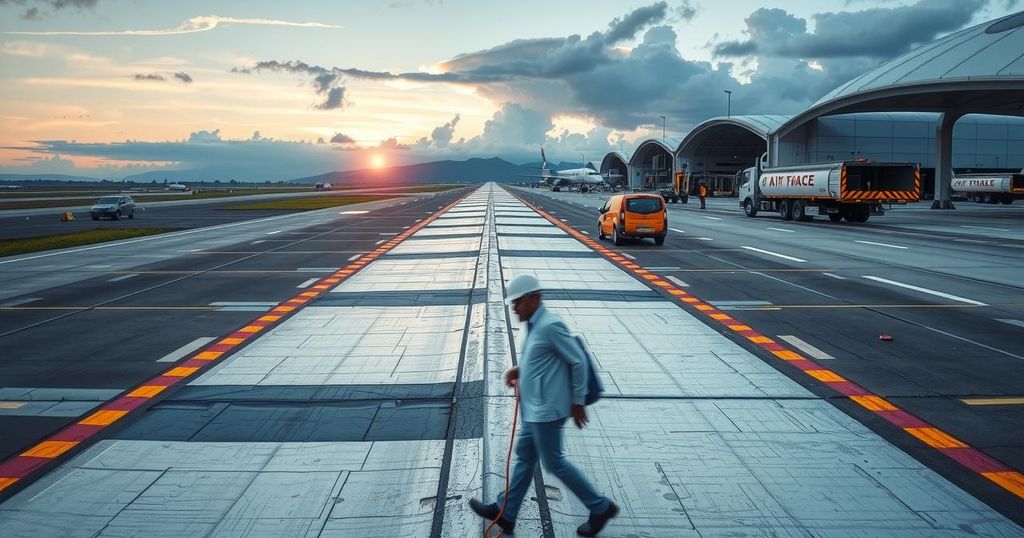Weather
World news
AEROSPACE, AFRICA, AVIATION, CIVIL AVIATION, CIVIL AVIATION AUTHORITIES, COSTA RICA, DANIEL ODUBER QUIROS INTERNATIONAL, DANIEL ODUBER QUIROS INTERNATIONAL AIRPORT, DANIEL ODUBER QUIRÓS INTERNATIONAL AIRPORT, FLIGHT RESUMPTION, GUANACASTE, GUANACASTE PROVINCE, LIBERIA, LIBERIA AIRPORT, LIBERIA INTERNATIONAL, LIBERIA INTERNATIONAL AIRPORT, LIR, LUIS MIRANDA, MINISTRY OF PUBLIC WORKS AND TRANSPORT, MIRANDA, NATURAL DISASTERS, NORTH AMERICA, RAIN, TRAVEL ADVISORY
Fatima Khan
0 Comments
Liberia Airport Resumes Operations Following Runway Repairs After Pothole Issues
Liberia Airport recently paused operations due to runway potholes, impacting flights on December 28. The runway at Daniel Oduber Quirós International Airport was closed for repairs, delaying flight schedules. While the closures are not uncommon, they highlight the challenges airports face in balancing maintenance needs with operational continuity.
Recently, operations at Liberia Airport in Guanacaste, Costa Rica faced significant disruptions due to runway conditions. On December 28, the Daniel Oduber Quirós International Airport (LIR) was temporarily closed following the discovery of two potholes on the runway. This prompted airport authorities to delay and redirect flights to ensure the safety of all aircraft operations. The Deputy Director of Civil Aviation, Luis Miranda, indicated that a standard protocol involves assessing the runway condition after each landing and, given the detachment caused by landings, the decision was made to close the runway for repairs.
Although the initial closure was set to last a couple of hours, it extended until shortly before 20:00 as repairs took longer than anticipated. By this time, approximately eight planes were awaiting clearance to depart. This incident is not an isolated occurrence; the airport previously faced a significant 12-hour closure on November 15 due to similar runway issues, impacting over 35 international flights and urging passengers to check with their airlines for updates.
Runway maintenance is critical for ensuring safety but can lead to challenges regarding flight operations. The necessity for timely runway repairs often clashes with operational demands, as seen at global airports like Brisbane and Mumbai. Both locations have faced their own unique runway maintenance challenges, further emphasizing the universal need for robust maintenance protocols to minimize the impact of wear and tear, particularly during adverse weather conditions. Effective runway maintenance strategies can include various cleaning and repair techniques to keep airport operations running smoothly, regardless of the challenges presented by the environment.
Moreover, it is often customary for most significant maintenance activities to be conducted during nighttime hours when air traffic is low, allowing for minimal disruption. This systematic approach underscores the importance of effective planning in the aviation industry, showcasing how routine maintenance is essential to uphold safety and efficiency for all air traffic.
The resilience and safety of airport operations hinge on regular maintenance of key infrastructures like runways. The recent situation at the Liberia Airport underscores the complexities involved in airport management where maintenance and flight safety coexist under challenging conditions. Runway repairs can be necessitated by everyday wear and tear, exacerbated by environmental influences that impact surface integrity. It is essential for both airport authorities and airline operators to prioritize safety while maintaining operational schedules, which necessitates careful planning.
In conclusion, the temporary closure of Liberia Airport illustrates the critical importance of runway maintenance to aviation safety. Although the duration of the closure exceeded initial estimates, this proactive approach ensured that flights could resume safely. The challenges of maintaining airport infrastructure, particularly runways, underscore the ongoing need for meticulous planning and execution of maintenance activities to safeguard the safety and efficiency of air travel.
Original Source: simpleflying.com




Post Comment